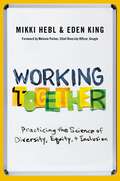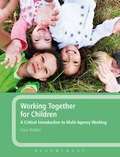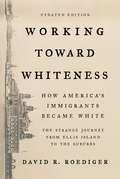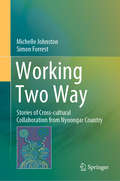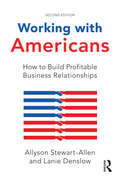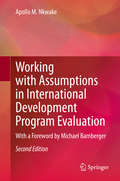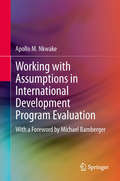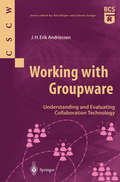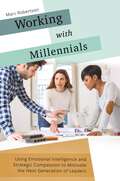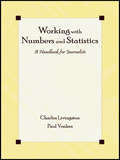- Table View
- List View
Working to Be Someone: Child Focused Research and Practice with Working Children (PDF)
by Anne Wihstutz Antonella Invernizzi Beatrice Hungerland Bernard Schlemmer Brian Milne Deborah Levison Dieter Kirchhöfer Dominique Pierre Plateau Fabrizio Terenzio Hamidou Coly Jeylan Mortimer Jim Mckechnie Madeleine Leonard Manfred Liebel Maria Teresa Tagliaventi Martha Areli Sánchez Martin Woodhead Michael Bourdillon Nandana Reddy Phillip Mizen Sandy Hobbs Vinod Chandra Virginia Morrow William Myers Zandra Pedraza-GómezWorking to be Someone presents an overview of worldwide research on working children that considers children's own views of employment in favour of adult-constructed arguments about child work. This book brings together contributions by internationally renowned researchers who are committed to a 'subject-orientated' approach as well as views and observations of activists from organizations that either work with child labour or support working children's movements. Chapters examine the traditionally widespread care and domestic work carried out by children, discuss localized explorations of working children - for example in Morocco, India and Europe - as well as consider work as a means for children to contribute economically to the family. Contributors also discuss children's movements and organizations in Africa, Asia and South America that claim work as a necessity for survival as well as a key to children's own agency and citizenship. This book is a key text for both academics and social work practitioners that encourages re-evaluation of the notion of childhood and understands the complex phenomenon of working children.
Working Together: Practicing the Science of Diversity, Equity, and Inclusion
by Mikki Hebl Eden KingThe racial and gender reckonings exemplified by the #BLM and #MeToo Movements shine light on biases that affect every part of life, including the workplace. An unspoken truth underlying the terrible events that fuel these movements-the deaths of George Floyd and Breonna Taylor, acts of xenophobia against Asian people during the COVID-19 pandemic, the sexual violence perpetrated by Harvey Weinstein- is that people are being harassed, stereotyped, demeaned, and victimized in the context of work. Police officers and movie producers are perpetrators of terrible actions while they are working. What is happening in the American workplace to allow these events to unfold? And, of critical importance, what can leaders do to make lasting change? In this critical moment in our nation's history, organizational leaders have the opportunity and obligation to build strategy and practice in support of diversity, equity, and inclusion. This book will help all leaders rise to the challenge by describing state-of-the art science and practice. Expert scholars and professionals blend descriptions of case studies with large-scale robust evidence to help leaders recognize the imperative of diversity, equity, and inclusion in organizations, identify their own personal barriers and those of their organizations, and specify strategies for achieving positive and persistent change by working together.
Working Together: Practicing the Science of Diversity, Equity, and Inclusion
by Mikki Hebl Eden KingThe racial and gender reckonings exemplified by the #BLM and #MeToo Movements shine light on biases that affect every part of life, including the workplace. An unspoken truth underlying the terrible events that fuel these movements-the deaths of George Floyd and Breonna Taylor, acts of xenophobia against Asian people during the COVID-19 pandemic, the sexual violence perpetrated by Harvey Weinstein- is that people are being harassed, stereotyped, demeaned, and victimized in the context of work. Police officers and movie producers are perpetrators of terrible actions while they are working. What is happening in the American workplace to allow these events to unfold? And, of critical importance, what can leaders do to make lasting change? In this critical moment in our nation's history, organizational leaders have the opportunity and obligation to build strategy and practice in support of diversity, equity, and inclusion. This book will help all leaders rise to the challenge by describing state-of-the art science and practice. Expert scholars and professionals blend descriptions of case studies with large-scale robust evidence to help leaders recognize the imperative of diversity, equity, and inclusion in organizations, identify their own personal barriers and those of their organizations, and specify strategies for achieving positive and persistent change by working together.
Working Together For Children: A Critical Introduction To Multi-agency Working (PDF)
by Gary WalkerWorking Together for Children provides a factual and analytical introduction to the systems and processes of multi-agency work with children and families. It is for trainee practitioners in childcare, education, social work and health care, and for those going on to work, or already working, in such settings who are looking to be more effective practitioners. Reflection on practice is a theme running throughout the book. To assist readers with this, there are two types of feature: information boxes, giving further factual details of particular areas related to multi-agency work; and reflective exercises containing case studies, vignettes or statements, followed by questions designed to stimulate reflection on issues raised in the text. Readers should find Working Together for Children incredibly useful for having both an introduction to policy/frameworks and a full and critical evaluation of these in one place.
Working Toward Whiteness: How America's Immigrants Became White: The Strange Journey From Ellis Island To The Suburbs
by David R. RoedigerWorking Two Way: Stories of Cross-cultural Collaboration from Nyoongar Country
by Michelle Johnston Simon ForrestThis book describes an action research approach to engaging respectfully with First Nations communities in a diverse range of contexts, disciplines and projects. It offers a valuable guide for professionals, students and teaching staff that recognises all participants as equal partners while acknowledging the diversity of First Peoples and culture, and prioritising local knowledge. While the book is adaptable to a diverse range of cultures and disciplines, it is specifically focused on cross-cultural collaborative case studies in Noongar Country, which is located in the southwest of Western Australia. The case studies demonstrate how action research can be applied not only in the traditional areas of education and social justice, but also in a diverse range of disciplines, communities and circumstances, including media, education, environmental management and health. The book’s aim is to highlight successful cross-cultural First Nations community projects and to discuss each one in terms of its action research philosophy and process. In this regard, the voices of the participants are prioritised, especially those of First Nations communities. While this book is specifically pitched at Australian readers, the action research approach described may be adapted and applied to many cross-cultural collaborative relationships, making it of interest and value to international students and researchers.
Working with Adults At Risk of Harm (UK Higher Education OUP Humanities & Social Sciences Health & Social Welfare)
by Margaret Greenfields Roger Dalrymple Agnes Fanning"This important book brings together valuable resources and insights in a key area of practice which has often been overlooked, and where disadvantage and discrimination are rife, but which also deserves and demands serious attention of the kind offered here."Roger Smith, Professor of Social Work Research, De Montfort University, UKThis comprehensive book uniquely acknowledges the overlap between different states of adult vulnerability within a range of health, social care and community contexts. The book looks beyond social work practice and legislative focus to examine the categories of ‘at risk’ and ‘vulnerable adults’. These include often forgotten groups such as homeless people, prisoners and migrant workers.Through a range of practical examples, the book illustrates how professionals can usefully and effectively intervene to lessen the chance of a member of an excluded community becoming at greater ‘risk’ of further vulnerability. The book includes:Explanations of core themes and implications for a range of professionals and service providers with a practical and accessible focus Case studies and practice examples from work with vulnerable groups Illustrative examples of how different states of vulnerability are frequently contingent upon one another Working with Adults at Risk from Harm is ideal for third-year undergraduate students and Master's students in the fields of social work, social care, community health and education, as well as staff working in public sector who will have contact with vulnerable individuals in their professional life. Contributors: Jill Aitken, David Bailey, Jennifer Burton, Caroline Cole, Jo Edwards, Michael Farquharson, Lalage Harries, Tennyson Mgutshini, Melanie Parris and Kate Potter.
Working with Americans: How to Build Profitable Business Relationships
by Allyson Stewart-Allen Lanie DenslowAnybody who has ever done business with Americans can testify that there are more differences than similarities between the US business culture and those in the rest of the world. Whether it’s values, etiquette, communication, influencing or negotiating, there’s a clear American style. How you go about building successful and profitable business relationships in the US should be guided by the many important lessons and insights offered in this essential reference guide. Authors Allyson Stewart-Allen and Lanie Denslow capture the current US business environment in this second edition, providing you with a deeper understanding of America’s business mindset, diversity and regions so you can confidently navigate this large, complex and profit-making economy. Whether new to working with Americans or an experienced internationalist, this book will serve as your ready reference for connecting with US colleagues, clients, customers or consultants. You’ll discover what drives American informality, schedules and the desire to combine fun with business. Each independent chapter allows you to dip into specific topics or sections that interest you. All are grounded in evidence-based research on cross-cultural working, behavioral science and leadership. It’s the ultimate guide for busy business leaders regardless of sector or company size.
Working with Americans: How to Build Profitable Business Relationships
by Allyson Stewart-Allen Lanie DenslowAnybody who has ever done business with Americans can testify that there are more differences than similarities between the US business culture and those in the rest of the world. Whether it’s values, etiquette, communication, influencing or negotiating, there’s a clear American style. How you go about building successful and profitable business relationships in the US should be guided by the many important lessons and insights offered in this essential reference guide. Authors Allyson Stewart-Allen and Lanie Denslow capture the current US business environment in this second edition, providing you with a deeper understanding of America’s business mindset, diversity and regions so you can confidently navigate this large, complex and profit-making economy. Whether new to working with Americans or an experienced internationalist, this book will serve as your ready reference for connecting with US colleagues, clients, customers or consultants. You’ll discover what drives American informality, schedules and the desire to combine fun with business. Each independent chapter allows you to dip into specific topics or sections that interest you. All are grounded in evidence-based research on cross-cultural working, behavioral science and leadership. It’s the ultimate guide for busy business leaders regardless of sector or company size.
Working with Assumptions in International Development Program Evaluation: With a Foreword by Michael Bamberger
by Apollo M. NkwakeThis book discusses the crucial place that assumptions hold in conceptualizing, implementing, and evaluating development programs. It suggests simple ways for stakeholders and evaluators to 1) examine their assumptions about program theory and environmental conditions and 2) develop and carry out effective program monitoring and evaluation in light of those assumptions. A survey of evaluators from an international development agency reviewed the state of practice on assumptions-aware evaluation. This 2nd edition has been updated with further illustrations, case studies, and frameworks that have been researched and tested in the years since the first edition.Regardless of geography or goal, development programs and policies are fueled by a complex network of implicit ideas. Stakeholders may hold assumptions about purposes, outcomes, methodology, and the value of project evaluation and evaluators—which may or may not be shared by the evaluators. A major barrier to viable program evaluations is that development programs are based on assumptions that often are not well articulated. In designing programs, stakeholders often lack clear outlines for how implemented interventions will bring desired changes. This lack of clarity masks critical risks to program success and makes it challenging to evaluate such programs. Methods that have attempted to address this dilemma have been popularized as theory of change or other theory‐based approaches. Often, however, theory-based methods do not sufficiently clarify how program managers or evaluators should work with the assumptions inherent in the connections between the steps. The critical examination of assumptions in evaluation is essential for effective evaluations and evaluative thinking. "How does one think evaluatively? It all begins with assumptions. Systematically articulating, examining, and testing assumptions is the foundation of evaluative thinking… This book, more than any other, explains how to build a strong foundation for effective interventions and useful evaluation by rigorously working with assumptions." —Michael Quinn Patton, PhD. Author of Utilization-Focused Evaluation and co-editor of THOUGHTWORK: Thinking, Action, and the Fate of the World, USA. "This updated edition presents us with a new opportunity to delve into both the theoretical and practical aspects of paradigmatic, prescriptive, and causal assumptions. We need to learn, and apply these insights with the deep attention they deserve." —Zenda Ofir, PhD. Independent Evaluator, Richard von Weizsäcker Fellow, Robert Bosch Academy, Berlin, Germany. Honorary Professor, School of Public Leadership, Stellenbosch University, South Africa. “This thought-provoking book explains why assumptions are an essential condition within the theories and methodologies of evaluation; and how assumptions influence the ways that evaluators approach their work…It will enrich the ways that evaluators develop their models, devise their methodologies, interpret their data, and interact with their stakeholders.”—Jonny Morell, Ph.D., President, 4.669… Evaluation and Planning, Editor Emeritus, Evaluation and Program Planning
Working with Assumptions in International Development Program Evaluation: With a Foreword by Michael Bamberger
by Apollo M. Nkwake A major reason complex programs are so difficult to evaluate is that the assumptions that inspire them are poorly articulated. Stakeholders of such programs are often unclear about how the change process will unfold. Thus, it is so difficult to reasonably anticipate the early and midterm changes that need to happen in order for a longer-term goalto be reached. The lack of clarity about the “mini-steps” that must be taken to reach a long-term outcome not only makes the task of evaluating a complex initiative challenging, but reduces the likelihood that all of the important factors related to the long term goal will be addressed. Most of the resources that have attempted to address this dilemma have been popularized as theory of change or sometimes program theory approaches. Although these approaches emphasize and elaborate the sequence of changes/mini steps that lead to the long-term goal of interest and the connections between program activities and outcomes that occur at each step of the way, they do not do enough to clarify how program managers or evaluators should deal with assumptions. Assumptions, the glue that holds all the pieces together, remain abstract and far from applicable. In this book the author tackles this important assumptions theme head-on-covering a breadth of ground from the epistemology of development assumptions, to the art of making logical assumptions as well as recognizing, explicit zing and testing assumptions with in an elaborate program theory from program design, implementation, monitoring and evaluation.
Working with Children in Care: European Perspectives (UK Higher Education OUP Humanities & Social Sciences Health & Social Welfare)
by Pat Petrie Janet Boddy Claire Cameron Valerie Wigfall Antonia SimonHow does residential care in England compare with that of other European countries? What is social pedagogy, and how does it help those working with children in care?How can child care policy and practice be improved throughout the United Kingdom? This book is written against the background of the gross social disadvantage suffered by most looked-after children in England. It compares European policy and approaches – from Belgium, Denmark, France, Germany and the Netherlands – to the public care system in England. Drawing on research from all six countries, the authors analyze how different policies and practice can affect young people in residential homes. A particular focus is on the unique approach offered by social pedagogy, a concept that is commonly used in continental Europe. The book compares young people's own experiences and appraisals of living in a residential home, and the extent to which residential care compounds social exclusion. Based upon theoretical and empirical evidence, it offers solutions for current dilemmas concerning looked-after children in the United Kingdom, in terms of lessons learned from policy and practice elsewhere, including training and staffing issues.Working with Children in Care is key reading for students, academics and professionals in health, education and social care who work with children in residential care.
Working with Community Groups: Using Community Development as a Method of Social Work ILS 198 (International Library of Sociology)
by George W GoetschiusA report of the development of a service to housing estate community groups by the London Council of Social Service, based on 15 years of field work experience using the community development approach and method. First Published in 1969. Routledge is an imprint of Taylor & Francis, an informa company.
Working with Critical Realism: Stories of Methodological Encounters (Routledge Studies in Critical Realism)
by Alpesh Maisuria Grant BanfieldThis international and interdisciplinary collection gathers stories from researchers and research students about their methodological encounters with critical realism. Whether the contributors are experienced or novice researchers, they are predominantly new to critical realism. For various reasons, as the contributors’ detail, they have all been drawn to critical realism. It is well known that critical realism can be bewildering and even overwhelming to newcomers, especially to those unfamiliar with language of, and without a grounding in, philosophy. While there are now numerous and important introductory and applied critical realist texts that make critical realism more accessible to a broader audience, stories from newcomers have been absent – especially as part of a single collection. The significance and uniqueness of this collection lies in its documentation of first-hand reflective insights on the practical use and implementation of critical realism. The contributors feature critical realist inspired research journeys in Australia, England, Scotland, Belgium, Sweden, and Spain. The hope of this book is that the stories and accounts presented in it will inspire – or at least sufficiently arouse – the curiosity of others to explore critical realist possibilities, which we believe offer enormous value to serious researchers across and within all disciplines and subjects who are interested in rigorous intellectual work with a socially progressive purpose.
Working with Critical Realism: Stories of Methodological Encounters (Routledge Studies in Critical Realism)
by Alpesh Maisuria Grant BanfieldThis international and interdisciplinary collection gathers stories from researchers and research students about their methodological encounters with critical realism. Whether the contributors are experienced or novice researchers, they are predominantly new to critical realism. For various reasons, as the contributors’ detail, they have all been drawn to critical realism. It is well known that critical realism can be bewildering and even overwhelming to newcomers, especially to those unfamiliar with language of, and without a grounding in, philosophy. While there are now numerous and important introductory and applied critical realist texts that make critical realism more accessible to a broader audience, stories from newcomers have been absent – especially as part of a single collection. The significance and uniqueness of this collection lies in its documentation of first-hand reflective insights on the practical use and implementation of critical realism. The contributors feature critical realist inspired research journeys in Australia, England, Scotland, Belgium, Sweden, and Spain. The hope of this book is that the stories and accounts presented in it will inspire – or at least sufficiently arouse – the curiosity of others to explore critical realist possibilities, which we believe offer enormous value to serious researchers across and within all disciplines and subjects who are interested in rigorous intellectual work with a socially progressive purpose.
Working With Diagrams (Studies in Social Analysis #14)
by Lukas Engelmann, Caroline Humphrey Christos LynterisArising from the need to go beyond the semiotic, cognitive, epistemic and symbolic reading of diagrams, this book looks at what diagrams are capable of in scholarly work related to the social sciences. Rather than attempting to define what diagrams are, and what their dietic capacity might be, contributions to this volume draw together the work diagrams do in the development of theories. Across a range of disciplines, the chapters introduce the ephemeral dimensions of scientist’s interactions and collaboration with diagrams, consider how diagrams configure cooperation across disciplines, and explore how diagrams have been made to work in ways that point beyond simplification, clarification and formalization.
Working with Female Offenders: A Gender-Sensitive Approach
by Katherine van WormerPraise for Working with Female Offenders "Encyclopedic in scope and full of very relevant work drawn from the fields of biology, psychology, criminology, and corrections, this book is a must-read for those working with girl and women offenders." —Meda Chesney-Lind, Professor, Women's Studies University of Hawaii at Manoa "In this timely and thoughtful book, van Wormer provides a gender-sensitive lens through which the reader can examine pathways to female criminality, a global perspective on female crime and punishment, and innovative treatment approaches. This book is a must-have for any student or professional who wishes to truly impact and empower the lives of female offenders." —David W. Springer, Associate Dean for Academic Affairs, School of Social Work The University of Texas at Austin "This book is timely in light of promising developments that are taking place at every level of the criminal justice system. It is a must-read for policymakers, practitioners, academics, and students in criminal justice, social work, and other related fields." —Barbara E. Bloom, Professor, Criminology and Criminal Justice Studies Sonoma State University, California The first book to combine elements from the social work, counseling, and criminology fields to create a framework tailored to working with female offenders Taking into account the special needs of girls and women within a system designed by men for male offenders, Working with Female Offenders offers counselors, correctional officers, lawyers, probation officers—in short, anyone who works in some capacity with female offenders–an evidence-based, gentler approach for working effectively and successfully with girls and women in trouble with the law. Working with Female Offenders provides coverage devoted to the nature of female crime and to the institutional settings in which much of the female-specific programming is designed to take place. This timely volume equips professionals with proven counseling strategies tailored to fit this population. Practical guidelines are included for case management interventions, teaching skills of communication and assertiveness, and anger and stress management for female offender populations, as well as: A strengths/empowerment/restorative framework for counseling women in crisis Narratives from personal interviews with female offenders and correctional counselors Discussion of controversial topics such as prison homosexuality, AIDS in prison, girls in gangs, and women on death row Examples of successful, innovative programs for female offenders from the United States and abroad Working with Female Offenders addresses the unique challenges of female offenders and those who treat them, and provides a much needed addition to the literature on innovative programming for female offenders.
Working with Female Offenders: A Gender-Sensitive Approach
by Katherine van WormerPraise for Working with Female Offenders "Encyclopedic in scope and full of very relevant work drawn from the fields of biology, psychology, criminology, and corrections, this book is a must-read for those working with girl and women offenders." —Meda Chesney-Lind, Professor, Women's Studies University of Hawaii at Manoa "In this timely and thoughtful book, van Wormer provides a gender-sensitive lens through which the reader can examine pathways to female criminality, a global perspective on female crime and punishment, and innovative treatment approaches. This book is a must-have for any student or professional who wishes to truly impact and empower the lives of female offenders." —David W. Springer, Associate Dean for Academic Affairs, School of Social Work The University of Texas at Austin "This book is timely in light of promising developments that are taking place at every level of the criminal justice system. It is a must-read for policymakers, practitioners, academics, and students in criminal justice, social work, and other related fields." —Barbara E. Bloom, Professor, Criminology and Criminal Justice Studies Sonoma State University, California The first book to combine elements from the social work, counseling, and criminology fields to create a framework tailored to working with female offenders Taking into account the special needs of girls and women within a system designed by men for male offenders, Working with Female Offenders offers counselors, correctional officers, lawyers, probation officers—in short, anyone who works in some capacity with female offenders–an evidence-based, gentler approach for working effectively and successfully with girls and women in trouble with the law. Working with Female Offenders provides coverage devoted to the nature of female crime and to the institutional settings in which much of the female-specific programming is designed to take place. This timely volume equips professionals with proven counseling strategies tailored to fit this population. Practical guidelines are included for case management interventions, teaching skills of communication and assertiveness, and anger and stress management for female offender populations, as well as: A strengths/empowerment/restorative framework for counseling women in crisis Narratives from personal interviews with female offenders and correctional counselors Discussion of controversial topics such as prison homosexuality, AIDS in prison, girls in gangs, and women on death row Examples of successful, innovative programs for female offenders from the United States and abroad Working with Female Offenders addresses the unique challenges of female offenders and those who treat them, and provides a much needed addition to the literature on innovative programming for female offenders.
Working with Groupware: Understanding and Evaluating Collaboration Technology (Computer Supported Cooperative Work)
by J.H. Erik AndriessenGroupware is a technology designed to help people working in groups to communicate their ideas more easily. While traditional technologies such as the telephone qualify as groupware, the term is usually used to refer to a specific class of technologies that rely on modern computer networks, such as email, newsgroups and videophones. Working with Groupware introduces the basic concepts and brings together ideas from various disciplines to provide an integrated approach to the evaluation and design of groupware technology. Key features include an analysis of the successes and failures of collaborative technology.
Working With Men For Change (Gender, Change, And Society Ser.)
by Jim Wild. Wild, JimThis is a work that reflects the growing interest in issues relating to men and masculinities. This diverse collection by a team of contributors analyzes the composition and representation of masculine identities. Combining research with theory and strategies for activism, the work promotes practical ways of working with men to achieve change. Intentionally designed as a handbook, it provides effective and practical information for professionals in social welfare settings, trainers and activists in the community, as well as individual men who have their own personal agenda for change.
Working With Men For Change
by Jim Wild. Wild, JimThis is a work that reflects the growing interest in issues relating to men and masculinities. This diverse collection by a team of contributors analyzes the composition and representation of masculine identities. Combining research with theory and strategies for activism, the work promotes practical ways of working with men to achieve change. Intentionally designed as a handbook, it provides effective and practical information for professionals in social welfare settings, trainers and activists in the community, as well as individual men who have their own personal agenda for change.
Working with Millennials: Using Emotional Intelligence and Strategic Compassion to Motivate the Next Generation of Leaders
by Marc RobertsonThis book directly addresses the issues and problems that leaders face in today's business environment—and provides tangible and usable techniques to overcome these challenges.Millennial-generation managers and employees—those ages 18–35—have transformed business in America. More than any previous generation, they don't conform to the traditional ways of doing things. Rather than passively taking orders, Millennials thirst for engagement, expect to be part of a team, and need to be engaged in meaningful tasks. And they aren't as devoted to the corporation as much as they are to the product or service that's provided. This book guides readers—people in management positions or in any corporate setting—in embracing these key differences and nurturing their abilities to listen and empathize with coworkers, supervisors, and employees. Readers will also learn the best ways to encourage and motivate this unique generation in a way that is familiar to them and still serves to push them to work hard, improve, and grow.The book demonstrates how to lead and manage Millennials, explains how to motivate them, and describes how to help them develop professionally. It gives managers the tools and techniques to satisfy Millennials' need to advance rapidly in their careers—and explains how to become a supporter of this desire instead of appearing to stand in their way. Turning the traditional notion of business management on its head, it shows that taking a caring and humanistic approach to employees, coworkers, and colleagues leads to increased productivity, efficiency, and profitability. These same techniques that foster open communication and trust will help companies to create office cultures that encourage people to be self-motivated and minimize worker turnover.
Working with Millennials: Using Emotional Intelligence and Strategic Compassion to Motivate the Next Generation of Leaders
by Marc RobertsonThis book directly addresses the issues and problems that leaders face in today's business environment—and provides tangible and usable techniques to overcome these challenges.Millennial-generation managers and employees—those ages 18–35—have transformed business in America. More than any previous generation, they don't conform to the traditional ways of doing things. Rather than passively taking orders, Millennials thirst for engagement, expect to be part of a team, and need to be engaged in meaningful tasks. And they aren't as devoted to the corporation as much as they are to the product or service that's provided. This book guides readers—people in management positions or in any corporate setting—in embracing these key differences and nurturing their abilities to listen and empathize with coworkers, supervisors, and employees. Readers will also learn the best ways to encourage and motivate this unique generation in a way that is familiar to them and still serves to push them to work hard, improve, and grow.The book demonstrates how to lead and manage Millennials, explains how to motivate them, and describes how to help them develop professionally. It gives managers the tools and techniques to satisfy Millennials' need to advance rapidly in their careers—and explains how to become a supporter of this desire instead of appearing to stand in their way. Turning the traditional notion of business management on its head, it shows that taking a caring and humanistic approach to employees, coworkers, and colleagues leads to increased productivity, efficiency, and profitability. These same techniques that foster open communication and trust will help companies to create office cultures that encourage people to be self-motivated and minimize worker turnover.
Working With Numbers and Statistics: A Handbook for Journalists
by Charles Livingston Paul S. VoakesWorking With Numbers and Statistics: A Handbook for Journalists will bolster math skills and improve math confidence for journalists at all skill levels. Authors Charles Livingston and Paul Voakes developed this resource book to improve journalistic writing and reporting, enabling journalists to:*make accurate, reliable computations, which in turn enables one to make relevant comparisons, put facts into perspective, and lend important context to stories;*recognize inaccurate presentations, whether willfully spun or just carelessly relayed;*ask appropriate questions about numerical matters;*translate complicated numbers for viewers and readers in ways they can readily understand;*understand computer-assisted reporting; and*write livelier, more precise pieces through the use of numbers.The math is presented in a journalistic context throughout, enabling readers to see how the procedures will come into play in their work.Working With Numbers and Statistics is designed as a reference work for journalism students developing their writing and reporting skills. It will also serve professionals as a useful tool to improve their understanding and use of numbers in news stories.
Working With Numbers and Statistics: A Handbook for Journalists
by Charles Livingston Paul S. VoakesWorking With Numbers and Statistics: A Handbook for Journalists will bolster math skills and improve math confidence for journalists at all skill levels. Authors Charles Livingston and Paul Voakes developed this resource book to improve journalistic writing and reporting, enabling journalists to:*make accurate, reliable computations, which in turn enables one to make relevant comparisons, put facts into perspective, and lend important context to stories;*recognize inaccurate presentations, whether willfully spun or just carelessly relayed;*ask appropriate questions about numerical matters;*translate complicated numbers for viewers and readers in ways they can readily understand;*understand computer-assisted reporting; and*write livelier, more precise pieces through the use of numbers.The math is presented in a journalistic context throughout, enabling readers to see how the procedures will come into play in their work.Working With Numbers and Statistics is designed as a reference work for journalism students developing their writing and reporting skills. It will also serve professionals as a useful tool to improve their understanding and use of numbers in news stories.

